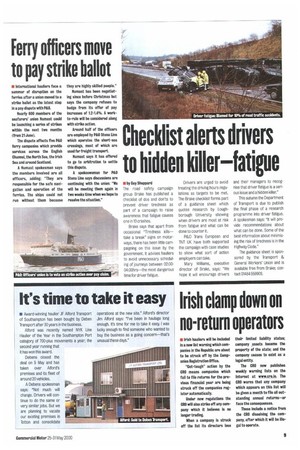Checklist alerts drivers to hidden killer—fatigue
Page 11

If you've noticed an error in this article please click here to report it so we can fix it.
II by Coy Sheppard
The road safety campaign
group Brake has published a checklist of dos and don'ts to prevent driver tiredness as part of a campaign to raise awareness that fatigue causes one in 10 crashes.
Brake says that apart from occasional "Tiredness kills— take a break" signs on motorways, there has been little campaigning on this issue by the government. It advises hauliers to avoid unnecessary scheduling of journeys between 02:0004:00hrs—the most dangerous time for driver fatigue.
Drivers are urged to avoid treating the driving hours regulations as targets to be met. The Brake checklist forms part of a guidance sheet which quotes research by Loughborough University showing when drivers are most at risk from fatigue and what can be done to counter it P&O Trans European and TNT UK have both supported the campaign with case studies to show what sort of action employers can take.
Mary Williams, executive director of Brake, says: "We hope it will encourage drivers and their managers to recognise that driver fatigue is a serious issue and a hidden killer."
This autumn the Department of Transport is due to publish the final phase of a research programme into driver fatigue. A spokesman says: "It will provide recommendations about what can be done. Some of the best information about minimising the risk of tiredness is in the Highway Code."
The guidance sheet is sponsored by the Transport & General Workers' Union and is available free from Brake; contact 01484559909.
















































































































